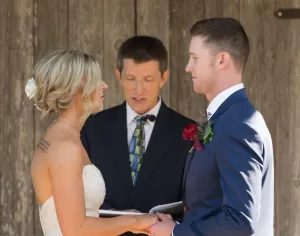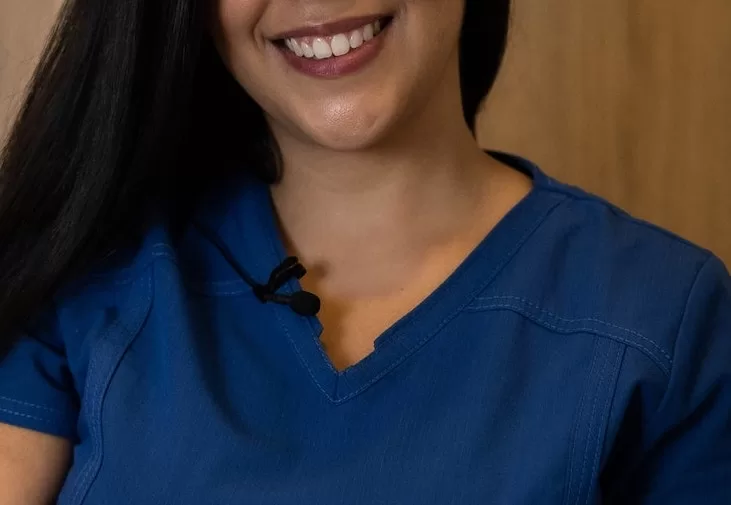Best Lapel (Lavalier) Microphone System That Won’t Break the Bank
by Chris Brower
Last Updated: March 11, 2024
If you’re going to provide a microphone for wedding ceremonies, you need to get a lavalier microphone system.
This is a standard piece of equipment in any DJ’s equipment. While you could possibly forgo it if you need to save money, you’ll frustrate wedding officiants (the people who lead the wedding ceremony). Trust me, I did just that when I didn’t have a lavalier available for them to use!
You’re a professional wedding DJ now, right? Get yourself a lavalier microphone system.

What’s a Lavalier Microphone?
A lavalier microphone is also known as a lapel mic. It is after all a small microphone that often clips on a shirt/jacket lapel, tie, or the top of a dress. It allows the person speaking to speak into a microphone, while their hands are free.
The lavalier microphone is small and unassuming. Some people might not even notice it. It’s what TV news anchors typically use.
Lavalier microphones are usually connected by a short cord to a transmitter pack, something the size of a deck of cards or so. This pack can be placed in a pocket or clipped on a belt (out of sight of other people). This pack then transmits the signal wirelessly to the receiver. The receiver is then plugged into a mixer.
The Lavalier Microphone System I Use
For years I’ve used the Shure BLX14/CVL system*, which has worked great. Great sound quality, and it’s durable and easy to use.
The Shure BLX14/CVL comes with all the main parts: lavalier microphone, transmitter, and receiver, so you don’t have to clumsily try to put together your own system from separate items (which runs the risk of things not working with each other).
When I bought the Shure BLX14/CVL, it was around $300. Before getting it, I had used two different, cheaper lavalier microphone systems, and they all performed poorly. The sound was super weak or hardly worked at all. It made ceremonies a greater challenge than they already are. I was nervous to spend a few hundred dollars on yet another lavalier microphone system, but I needed something reliable, and I’ve been happy with my purchase ever since!
What Equipment Do You Need with a Lavalier Microphone?
It’s not enough to have just the lavalier microphone. You’ll need a few other parts for everything to work:
- Lavalier microphone with clip for clipping it on a shirt/jacket/dress/tie/etc.
- Transmitter (lavalier microphone is plugged into this)
- Receiver (including a power cord to power the receiver)
- An XLR cord to connect the receiver into your mixer
- Windscreens for the microphone to cut down on extraneous noise
- AA batteries for the transmitter. And make sure to change batteries every couple weddings and have plenty of backups.
As mentioned earlier, the Shure BLX14/CVL system comes with a lavalier microphone (with clip), transmitter, and receiver, so that gives you a lot of the big parts. Likewise, other lavalier microphone systems may come with those parts too.
Ready for the complete guide to becoming a wedding DJ? Here you go.

How to Use a Lavalier Microphone
The microphone itself should be clipped to the clothing about three or four itches below the officiant’s chin. This can be on their shirt, jacket, tie, or the top center of their dress.
Try to then snake the cord around them in a way that makes it as least visible as possible.
- If the officiant has a jacket (sport coat, etc.), great! Just simply snake the cord behind the inside front of their jacket. They can place the transmitter portion in an inside jacket pocket or in their pants pocket.
- If they’re wearing a tie, they can also snake the cord down behind the tie.
In this example below, the officiant has the mic clipped to top of his tie and then actually has the cord going down the front of the tie. Normally the cord going down the front of the tie wouldn’t be my favorite spot, but the cord matches the front of the tie and you can barely see it. Are you having trouble seeing it? Good!

If the officiant isn’t wearing a jacket or a tie, you can snake the cord over their shoulder and behind them. In this photo below, you can see the microphone clipped on the shirt collar and then the cord disappearing over her shoulder and out of sight.

It’s not the end of the world if the audience can see some of the cord, but it’s nice when it’s mostly invisible.
The transmitter can typically just go in the officiant’s pocket. (If they don’t have any pockets, or somewhere they can clip the transmitter pack, then unfortunately, the officiant may just have to hold the transmitter.) Make sure the officiant turns on the transmitter when they need to use the mic and flip it off when they don’t. (On/Off will be a button/switch on the transmitter itself.) When I meet the officiant and give them the lavalier mic, I show them how to use it. Be sure to also have the officiant sound check it a few times to make sure everything sounds good.
The receiver part of the wireless microphone system is typically plugged into a mixer using an XLR cord. From the mixer you can control the volume, adjust the EQ, and make any other audio adjustments.
When to Use a Lavalier Microphone
Generally, you’ll only use a lavalier microphone during the ceremony so the officiant can speak into a microphone while their hands are free to hold notes, a religious text, the rings, etc.
Do the bride and groom need a lavalier mic too? In general, no. They likely won’t be saying much during the ceremony other than “I do.” If they are saying more, such as vows, the officiant can unclip the officiant’s lavalier microphone from their clothes and hold it out to the bride or groom.
The bride and groom are also likely to want to say some things in private, such as the nervous chatter of people about to be married in front of a huge group of people, which doesn’t need to be broadcasted. They may also get emotional too (aka, crying) during the ceremony, which can be a challenging audio situation! Plus, a lavalier mic on a white wedding dress is a major eyesore.
The ceremony is likely the only time you’ll need the lavalier microphone. For toasts during dinner, it’s better to use a wireless microphone, as those are easier to pass around among people giving speeches. A wireless microphone is one of the microphones that wedding DJs need.
Similarly, I recommend that DJs use a wireless microphone or wired microphone for their own emceeing, as those are generally louder and better sound quality than a lavalier mic. A lavalier mic can do great for the ceremony, but once dinner and the reception begins, it’s time to use a wired/wireless mic.
Don’t Have the Officiant Use a Handheld Microphone
One mistake wedding DJs make is asking the officiant to use a handheld microphone (such as a wireless mic) during the ceremony.
Want to get angry looks? Ask the officiant to do just that.
Officiants often need both hands free to hold notes, the wedding rings, or a Bible or other religious text. It becomes challenging holding those things with just one hand while the other hand tries to hold a microphone.
People giving speeches during dinner typically don’t mind holding a wireless microphone, as they rarely need both hands free. Same with someone doing a quick reading during the ceremony or other short thing.
What if instead of a lavalier microphone, you put a wireless microphone on a microphone stand during the ceremony? That would let the officiant have a microphone and still have their hands free…
Oh dear.
While, yes, this is a way to have a microphone for the officiant that keeps the officiant’s hands free, this is a real eyesore in photos. Because there you have the couple and the officiant and there’s a giant microphone stand (a tall pole) in the middle of it all. Not a great look.
Just get a lavalier microphone!
Any Downsides to Lavalier Microphones?
Lavalier microphones are small. Plus, they depend on wireless signals. Thus, the sound can sometimes be small too. That's one reason why it's preferable to use full-size wireless microphones or wired microphones for your emceeing or the guests making speeches during the reception.
Lavalier microphones also struggle with wind, for some reason. Even if you put a windscreen over your microphone (which you should), wind noises can sometimes be a problem if you're doing an outdoor ceremony on a windy day. The whoosh sound can take over the microphone if you're not careful.
If it's particularly windy out, I recommend discussing this with the officiant ahead of time and having a handheld wireless microphone ready to go as a last result. For example:
You to the officiant: If the wind noise becomes too loud, I recommend turning off the lapel mic, and I'll bring over a wireless microphone for you to use.
How to Fix Lavalier Microphone Problems
Not getting much volume? Here are some fixes:
- If you're having trouble getting a lot of volume without feedback, encourage the officiant to still speak up more, which will make it easier for the mic to pick up the sound.
- Try turning up the volume rather than turning up the gain on your mixer, as gain is likelier to trigger feedback. Certainly you'll want some gain, but don't depend on that to give you all the volume. Tinker with the volume, gain, and EQ knobs until you get the sound and volume you want.
- Change the placement of where the lavalier microphone is clipped on the officiant's clothing. Experiment with where gets the best sound. Sometimes the lavalier microphone may simply be too far away or in a spot that doesn't pick up volume well.
Wind making a lot of noise? Use windscreens to cut down on extraneous noise. If it's a windy day out, you may need to use a handheld wireless microphone instead, which, for some reason, seems to pick up less wind.
Getting weird static noises? Be sure to review our article, Easy Fix for Wireless Microphone Popping/Static Sound. Many of those same things apply to lavalier microphone systems. That may help you pinpoint the problem.
Conclusion
A lavalier microphone is an essential part of any wedding DJ's equipment. Be sure to get one so officiants can use them during the ceremony. I've used the Shure BLX14/CVL system for years and been happy with it, but there are lots of other lavalier microphone systems that may work great for you.
Related Articles:
- Complete Wedding DJ Equipment Guide
- 3 Microphones Wedding DJs Need
- Easy Fix for Wireless Microphone Popping/Static Sound
- How to Use a Sound Mixer for Wedding DJs
- The Wedding DJ "Just in Case" Kit
- Ugh! All the Other Wedding DJs Have Better Equipment Than I...
- Don't Forget These Tools and Accessories for Your Wedding DJ Business
*If you click the product links and make a purchase, we earn a commission. This helps pay for this website and other expenses. This is at no additional cost to you.
